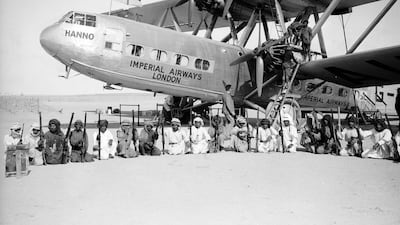DUBAI // It was one the first passenger aircraft to land in the Emirates, over 80 years ago, and was regarded as the Concorde of its day.
Now, a team of aviation enthusiasts are hoping to build an exact replica of the HP42, a four-engine biplane that once connected Sharjah with the rest of the world.
To honour its contribution to aviation history, UK-based non-profit Team Merlin will build a working replica out of the original materials and according to the original specifications.
Once ready, the plane will fly the original routes of the 1930s aircraft, including making a stop at Sharjah airport.
“If you had to choose an aircraft that was synonymous with early aviation in Sharjah at that time, it would be the HP42,” said Neil Farley, from Team Merlin.
“We’ve got a lot of accounts and pictures of people who flew on the plane to Sharjah and stayed at a guesthouse there.
“Sharjah will be one of the biggest stops on the tours we will make with the aircraft.”
A small fleet of the aircraft was operated by Imperial Airways in the inter-war aviation golden age between 1930 and 1940.
Four were stationed at Croydon, London, and flew to the majority of European destinations.
Four more were based at Cairo, Egypt, and flew to Sharjah, as well as other stops in the Gulf of Oman and further afield to India.
The aircraft was featured in a 1937 short film, entitled “Air Outpost — 24 Hours at the City and Airport of Sharjah”.
About 20 years ago, Team Merlin built a replica of a Vickers Vimey, a 1919 bomber, and this is the group’s first major project since then.
Over the last 10 years, Mr Farley and about 60 other volunteers have scoured the globe for original blueprints of the aircraft, as well as fuselage and parts.
Their research has taken them as far afield as Canada, where they found a huge stash of notes from among the post-war émigré community.
“We now have enough source material to start building the aircraft,” said Mr Farley.
It will take about three years to build, Mr Farley said, at a cost of Dh93 million.
Team Merlin has funded its work over the years through money from its own members, and is currently seeking sponsorship or donations to complete its work on the HP42.
Mr Farley said that because of the connection between the HP42 and the UAE’s own aviation history, he also has his fingers crossed for backing from within the Emirates.
An easy way to raise money for the project would be by offering a passenger service with the aircraft.
However, Mr Farley said that because of tight regulation on passenger aircraft, the original design would have to be modified greatly, including using inflatable ramps at the doors of the aircraft. So much so, he said, that it would lose its authenticity.
Although the HP42 had a 100 per cent safety record, Mr Farley said his team had made “tweaks” to the design.
For instance, the original magnesium-based alloy for the hull would have a better quality, less brittle, composition. The Irish linen used to cover the wings, too, would also be of a better quality, he said.
Mr Farley said that although he needs to put a radio in the aircraft, he is hoping to use a refitted original transistor radio, complete with glowing valves.
The actual effort of digging through old, historic records and gathering it in one place has had the added benefit of preventing details about the HP42 from being lost to the past, said Mr Farley.
“It’s got such an interesting social history, as well as being of aeronautical historical importance,” he said.
“It was the first real airliner. It was the first aircraft where people sat inside in comfort, rather than being in coats on the outside. Pilots were in comfort, and passengers had seat belts.
“These little things we take for granted today, but it was HP42 that set the standard.”
mcroucher@thenational.ae

